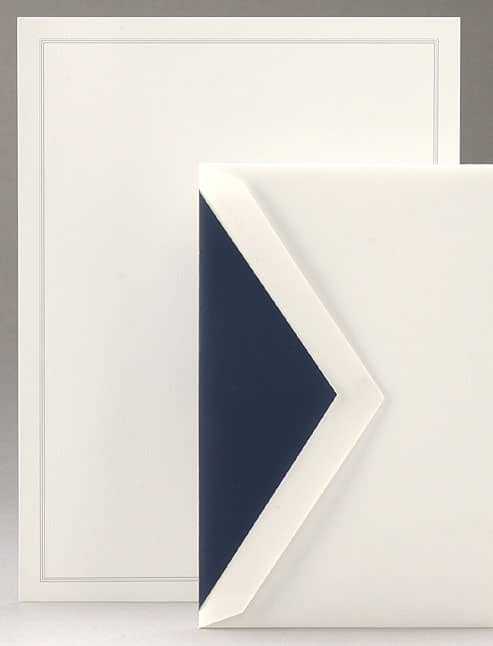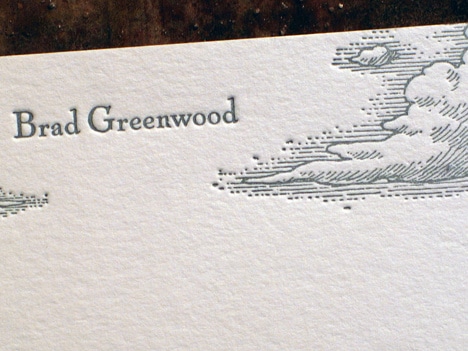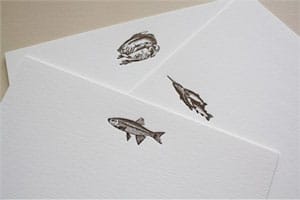
We previously began a series of posts on the lost art of letter writing. In hopes of resurrecting this splendid tradition, we will be presenting various posts on all the ins and outs of classic correspondence. Today we cover the foundation of the art of letter writing: stationery.
If you are writing a casual letter to a friend or family member, quality stationery is a nice touch, but definitely not necessary. Your friend is not likely to take note of the excellent texture of your paper and respond with, “Handsome stationery, Dude!”
But for some kinds of correspondence, only real stationery will do. If you are writing a love letter, a sympathy note, a thank you card, or a letter of congratulations, you don’t want to send such meaningful musings on paper you tore out of your spiral notebook. Quality stationery adds a weight of sincerity to your words.
Quality stationary makes writing a true pleasure and creates a distinct impression on those lucky enough to receive your letters. If you have only bought mass-produced stationery, this point may seem dubious. But quality stationery is truly an artistic luxury. Quality stationery is still made in small batches by manly craftsmen toiling in their studios. And surprisingly, there’s a lot to know when picking out a set to purchase. So here is a guide to investing in paper you’ll be proud to put your ink to.
Stationery
Since quality stationery forms the foundation of a man’s letter writing arsenal, investing in quality, personalized/monogrammed cards, papers, and envelopes is a wise decision. Your recipient will know a letter from you has arrived the moment they open the mailbox. Choose stationery with simple, classic style: white or ecru paper with black, blue, or gray ink. Having a few sets of the following types at hand will ready you for the writing of any kind of letter, both formal and long and short and casual.
Correspondence Cards
Men have traditionally used the correspondence card over folded note cards or letter sheets for their communications. Letter writing need not always involve the writing of long tomes; the task of filling a large sheet of paper may seem too daunting and keep you from ever getting started. Instead, try sending off shorter notes more frequently. The correspondence card, simple, flat, heavyweight, and typically 4×6 in size, is ideal for this purpose. Correspondence cards often have a colored border, and while it’s appropriate to put your name across the top, having your initials in the corner in the classiest way to go.
Social Sheets

Slightly larger than the correspondence card (usually about 6×8), social sheets also make excellent stationery for shorter notes. You simply fold them in half and place them in an envelope. You may add just your name, or your name, address, and coat of arms to the top of the sheets. They can be used for longer missives too; just order plain sheets for additional pages. As with all stationery, the first page can be embellished with a monogram or design while additional sheets should be plain. Do not write on the back of these sheets; if you need more room, continue onto a new page.
Monarch Sheets

Monarch sheets, which are also known as executive stationery, typically measure around 7×10 and are used for longer correspondences. You can embellish them similarly to the social sheets, keeping in mind that adding one’s address makes the stationery appear more formal and business-like. When purchasing embellished monarch sheets, also order blank sheets for letters than go beyond the first page.
Stationery Embellishments
When purchasing stationery you will likely wish to embellish it with your name, address, family coat of arms, or some combination of these things. Basic stationery will print these embellishments in the conventional way, and are acceptable for the man on a budget. But if you’re thinking about investing in higher quality stationery or asking for stationery as a gift, you should look into printing methods which lend the embellishments a more formal and distinctive texture and appearance. There are several options for this, and you should choose the one that best suits your aesthetic desires and budget.
Engraving
If you want to give your stationery the most distinctive look and feel possible, and you’re willing to pay top dollar to get it, then engraving is for you. Engraving, which dates from Medieval Europe, is the oldest process for creating embellishments. It is still done much like it was centuries ago. For each order, a new copper plate must be made. The copper plate is engraved with the text or design desired. Ink is spread over the plate, then wiped off, leaving only the ink in the engraving. Paper (and only the highest quality paper will suffice) is then forcefully pressed against the plate; so forcefully that the paper enters the etchings and the ink is transferred. The force of the impression leaves the lettering with a raised effect you can feel on the front of the paper and a “bruise” on the back. The result is the most handsome, formal, and sharpest possible embellishment. It’s also the most expensive. But while the price for your first engraved stationery is quite steep, much of that cost is from the making of the copper plate. Once you purchase your own plate, re-ordering the stationery becomes less expensive.
Thermography
For those who cannot afford engraving but desire something nicer than digital printing, adding thermography to the a conventional wet-ink printing process is a welcome option. Thermography involves placing resin power on the printed ink and then baking the embellishment. The baking raises the ink, giving it a texture that can be felt on the front of the paper. It can’t quite touch the look and feel of engraving, but it certainly approaches it.
Here’s a video from Crane’s explaining the difference between engraving and thermography and giving you a look at the complex process that makes engraving so expensive:

From Greenwich Letterpress
Letterpress printing is the oldest kind of printing, and it is also enjoying quite a renaissance these days. Involving moveable type or images, it’s a process of relief printing in which a plate with a reversed, raised surface is inked, and then paper is pressed on top of the raised surface, transferring the ink. Think of letterpressing as the opposite of engraving; the resulting lettering is indented into the paper instead of being raised. The look is less sharp than engraving but can be quite texturally and graphically interesting. Letterpress is typically done by small studios, using hand-operated presses, and thus can only be done in small batches. It is therefore only a little less, or just as, expensive as engraving.
Here’s a short documentary about a guy who takes letterpressing very seriously:
Where to Buy
There are many companies out there that produce high-quality stationery. Be sure to check out examples of their work and get a feel for their reputation before investing in your new stationery. If you want to buy the cream of the crop, and you’ve got some cash to burn, check out Crane and Co., Dempsey and Carroll, and Piccolo Press (for those in the UK). They’re some of the oldest and best in the biz. If you’re looking for letterpress stationery, there are lots of small companies out there that make graphically interesting designs like Page Stationery. If you’re on a budget and just want some stationery to get started, American Stationery has some options that are not too shabby.
Remember, many companies will send you a sample of their stuff before you buy, so you don’t have to make your purchase sight unseen. And you might want to simply check out your local fine stationery store, where you can get some personal attention and see and feel everything before you buy.
Tags: Writing


